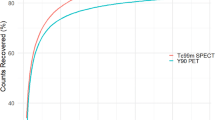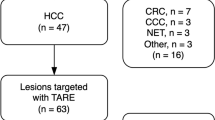Abstract
Objectives
To determine the realized tumor to normal ratios (TNRs) in patients undergoing radiation segmentectomies (RS); determine the relationship between TNRs and particle load in transarterial radioembolization (TARE).
Methods
In total, 148 patients who underwent 184 TARE procedures for hepatocellular carcinoma were evaluated. Post treatment SPECT CT bremsstrahlung imaging was analyzed utilizing Simplicit90y™ to determine realized TNR. A model which normalized activity across all RS treatments to a level that would achieve 400 Gy by unicompartmental dosing was created to determine the affect realized TNR would have on tumor absorbed dose.
Results
The mean TNR in the setting of RS was 2.88 ± 1.60 and was higher for glass as compared to resin microspheres (3.07 ± 1.68 vs 2.24 ± 1.21, p = 0.01). The TNR was significantly greater in the RS as compared to the lobar deliveries (2.88 ± 1.60 vs 2.16 ± 1.12, p < 0.01). When normalizing the activity of RS treatments to the level required to achieve 400 Gy by unicompartmental calculations, there was found to be significant differences in the predicted tumor absorbed dose when separated by the median tumor dose (601.2 ± 133.3 vs 1146.9 ± 297.5, p < 0.01) or median realized TNR (1119.2 ± 341 Gy vs 635.7 ± 160.2 Gy, p < 0.01). Particle load was found to be associated with TNR on univariate (p < 0.01) and multivariate (p < 0.01) analysis.
Conclusion
Significant TNRs are seen in RS and perhaps argue for the use of multi-compartmental dosimetry techniques in this setting and particle load may affect TNR.
Key Points
• Tumor to normal ratios were significantly higher in radiation segmentectomies than lobar deliveries.
• Tumor to normal ratios were significantly higher when utilizing glass, as compared to resin microspheres.
• When creating a model that prescribed the activity required to reach 400 Gy by MIRD, realized tumor dose varied significantly in radiation segmentectomies.


Similar content being viewed by others
Abbreviations
- BSA:
-
Body surface area
- CT:
-
Computed tomography
- HCC:
-
Hepatocellular carcinoma
- IQR:
-
Interquartile range
- MIRD:
-
Medical Internal Radiation Dose
- ROI:
-
Region of interest
- SPECT:
-
Single-photon emission computed tomography
- TARE:
-
Transarterial radioembolization
- Tc 99 m MAA:
-
Technetium-99 m macro-aggregated albumin
- TNR:
-
Tumor to normal ratio
- XRT:
-
External beam radiation
- y90:
-
Yttrium-90
References
Salem R, Fordon AC, Mouli S et al (2016) Y90 radioembolization significantly prolongs time to progression compared with hepatocellular carcinoma. Gastroenterology 151:1155–1163
Gulec SA (2016) Y-90 radiomicrosphere therapy for colorectal cancer liver metastases. Semin Nucl Med 46:126–134
Kuei A, Saab S, Cho SK, Kee ST, Lee EW (2015) Effects of yttrium-90 selective internal radiation therapy on non-conventional liver tumors. World J Gastroenerol 21:8271–8283
Garin E, Tselikas L, Guiu B et al (2021) Personalised versus standard dosimetry approach of selective internal radiation therapy in patients with locally advanced hepatocellular carcinoma (DOSISPHERE-01): a randomized multicentre, open-label phase 2 trial. Lancet Gastroenterol Hepatol 6:17–29
Levillain H, Derijckere ID, Ameye L et al (2019) Personalised radioembolization improves outcomes in refractory intra-hepatic cholangiocarcinoma: a multicenter study. Eur J Nucl Med Mol Imaging 46:2270–2279
Eaton BR, Kim HS, Schreibmann E et al (2014) Quantitative dosimetry for yttrium-90 radionuclide therapy: tumor dose predicts fluorodeoxyglucose positron emission tomography response in hepatic metastatic melanoma. J Vasc Interv Radiol 25:288–295
Vouche M, Habib A, Ward TJ et al (2014) Unresectable solitary hepatocellular carcinoma not amenable to radiofrequency ablation: multicenter radiology-pathology correlation and survival of radiation segmentectomy. Hepatology 60:192–201
Gabr A, Riaz A, Johnson GE et al (2021) Correlation of Y90-absorbed radiation dose to pathological necrosis in hepatocellular carcinoma: confirmatory multicenter analysis in 45 explants. Eur J Nucl Med Mol Imaging 48:580–583
Toskich B, Vidal LL, Olson MT et al (2021) Pathologic response of hepatocellular carcinoma treated with yttrium-90 glass microsphere radiation segmentectomy prior to liver transplantation: a validation study. J Vasc Interv Radiol 32:518–526
Salem R, Padia SA, Lam M et al (2019) Clinical and dosimetric considerations for Y90: recommendations from an international multidisciplinary working group. Eur J Nucl Med Mol Imaging 46:1695–1704
Tafti BA, Padia SA (2019) Dosimetry of Y-90 microspheres utilizing Tc-99m SPECT and Y-90 PET. Semin Nucl Med 49:211–217
Villalobos A, Cheng B, Wagstaff W et al (2021) Tumor-to-normal ratio relationship between planning technetium-99 macroaggregated albumin and posttherapy ytrrium-90 bremsstrahlung SPECT/CT. J Vasc Interv Radiol 32:752–760
Lea WB, Tapp KN, Tann M et al (2014) Microsphere localization and dose quantification using positron emission tomography/CT following hepatic intraarterial radioembolization with yttrium-90 in patients with advanced hepatocellular carcinoma. J Vasc Interv Radiol 25:1595–1603
Garin E, Lenoir L, Edeline J et al (2013) Boosted selective internal radiation therapy with 90Y-loaded glass microspheres (B-SIRT) for hepatocellular carcinoma patients: a new personalized promising concept. Eur J Nucl Med Mol Imaging 40:1057–1068
Garin E, Lenoir L, Rolland Y et al (2012) Dosimetry based on 99mTc-macroaggregated albumin SPECT/CT accurately predicts tumor response and survival in hepatocellular carcinoma patients treated with 90Y-loaded glass microspheres: preliminary results. J Nucl Med 53:255–263
Hermann AL, Dieudonne A, Ronot M et al (2020) Relationship of tumor radiation-absorbed dose to survival and response in hepatocellular carcinoma treated with transarterial radioembolization with 90Y in the SARAH study. Radiology 296:673–684
Camphausen K, Moses MA, Menard C et al (2003) Radiation abscopal antitumor effect is mediated through p53. Cancer Res 63:1990–1993
Filatenkov A, Baker J, Mueller AM et al (2015) Ablative tumor radiation can change the tumor immune cell microenvironment to induce durable complete remissions. Clin Cancer Res 21:3727–3739
Haste P, Tann M, Persohn S et al (2017) Correlation of technetium-99m macroaggregated albumin and yttrium-90 glass microsphere biodistribution in hepatocellular carcinoma: a retrospective review of pretreatment single photon emission CT and posttreatment positron emission tomography/CT. J Vasci Interv Radiol 28:722–730
Pasciak AS, Abiola G, Liddell RP et al (2020) The number of microspheres in Y90 radioembolization directly affects normal tissue radiation exposure. Eur J Nucl Med Mol Imaging 47:816–827
Funding
The authors state that this work has not received any funding.
Author information
Authors and Affiliations
Corresponding author
Ethics declarations
Guarantor
The scientific guarantor of this publication is Shamar Young.
Conflict of interest
The authors of this manuscript declare relationships with the following companies: SY is a consultant for Boston Scientific. JG is a consultant for Sirtex Medical.
Statistics and biometry
Nathan Rubin and Linda Young kindly provided statistical advice for this manuscript.
Informed consent
Written informed consent was waived by the institutional review board.
Ethical approval
Institutional review board approval was obtained.
Methodology
• retrospective
• observational
• performed at one institution
Additional information
Publisher's note
Springer Nature remains neutral with regard to jurisdictional claims in published maps and institutional affiliations.
Rights and permissions
About this article
Cite this article
Young, S., Chen, T., Flanagan, S. et al. Realized tumor to normal ratios in hepatocellular carcinoma patients undergoing transarterial radioembolization: a retrospective evaluation. Eur Radiol 32, 4160–4167 (2022). https://doi.org/10.1007/s00330-021-08501-9
Received:
Revised:
Accepted:
Published:
Issue Date:
DOI: https://doi.org/10.1007/s00330-021-08501-9




